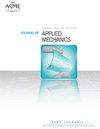通过电流诱导空隙生长估算金属薄膜粘附强度的非接触方法
IF 2.8
4区 工程技术
Q2 MECHANICS
引用次数: 0
摘要
有研究报道,金属薄膜中电迁移引起的空隙生长速度与金属薄膜与基底层和钝化层的结合强度成反比。界面粘附强度对电迁移电阻的贡献随温度的升高而减小。本文从反应扩散驱动固体界面演化的广义热力学一致连续介质理论出发,推导了电迁移诱导的扩散孔洞生长速度表达式。这个关系式反映了与基体和钝化层的粘附对金属薄膜电迁移电阻的影响。在高温和高电流密度条件下,对镀在TiN基材上并经TiN或SiNx钝化的Cu金属薄膜进行了电迁移实验。界面粘接强度随温度的退化采用安德拉德型关系进行建模。将实验中表征的空洞生长速率与空洞生长速率表达式相结合,估算Cu-TiN和Cu-SiNx界面的界面粘附强度。通过与文献报道的机械去粘接试验的界面粘接强度比较,验证了估计金属钝化层界面粘接强度的方法。本文章由计算机程序翻译,如有差异,请以英文原文为准。
A Non-contact Method for Estimating Thin Metal Film Adhesion Strength through Current Induced Void Growth
Abstract Studies have reported that the electromigration induced void growth velocity in metal thin films is inversely related to the adhesion strength of the metal thin film with the base and passivation layers. It was also observed that the contribution of interface adhesion strength to electromigration resistance decreases with increase in temperature. In this study an expression is derived for the diffusive void growth velocity induced by electromigration from a generalized thermodynamically consistent continuum-based theory for reaction-diffusion driven solid state interface evolution. This relation captures the effect of adhesion with the base and passivation layers on electromigration resistance of thin metal films. Electromigration experiments were carried out at elevated temperatures and high current density to induce voiding in thin Cu metal film deposited on a base layer of TiN and passivated with TiN or SiNx. The degradation of interface adhesion strength with temperature is modeled using an Andrade-type of relationship. The void growth rates characterized in these experiments are combined with the expression for void growth rate to estimate the interface adhesion strength for the Cu-TiN and Cu-SiNx interfaces. The methodology for estimating the adhesion strength of the metal-passivation layer interface is validated through comparison with interface adhesion strengths from mechanical de-adhesion tests reported in literature.
求助全文
通过发布文献求助,成功后即可免费获取论文全文。
去求助
来源期刊
CiteScore
4.80
自引率
3.80%
发文量
95
审稿时长
5.8 months
期刊介绍:
All areas of theoretical and applied mechanics including, but not limited to: Aerodynamics; Aeroelasticity; Biomechanics; Boundary layers; Composite materials; Computational mechanics; Constitutive modeling of materials; Dynamics; Elasticity; Experimental mechanics; Flow and fracture; Heat transport in fluid flows; Hydraulics; Impact; Internal flow; Mechanical properties of materials; Mechanics of shocks; Micromechanics; Nanomechanics; Plasticity; Stress analysis; Structures; Thermodynamics of materials and in flowing fluids; Thermo-mechanics; Turbulence; Vibration; Wave propagation

 求助内容:
求助内容: 应助结果提醒方式:
应助结果提醒方式:


